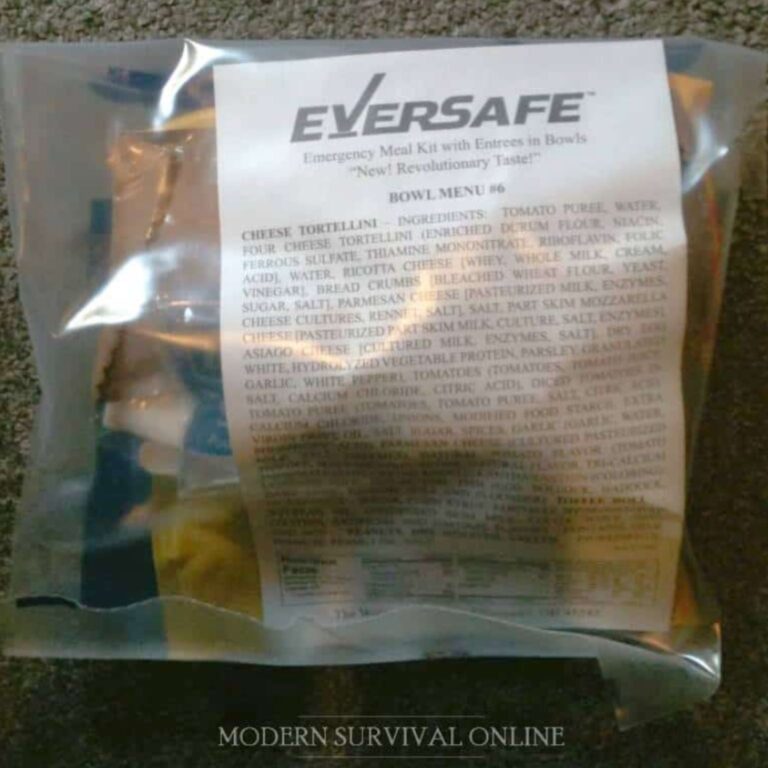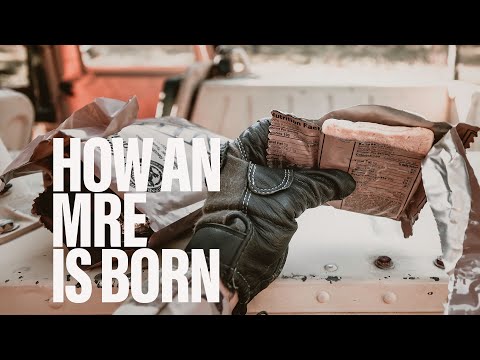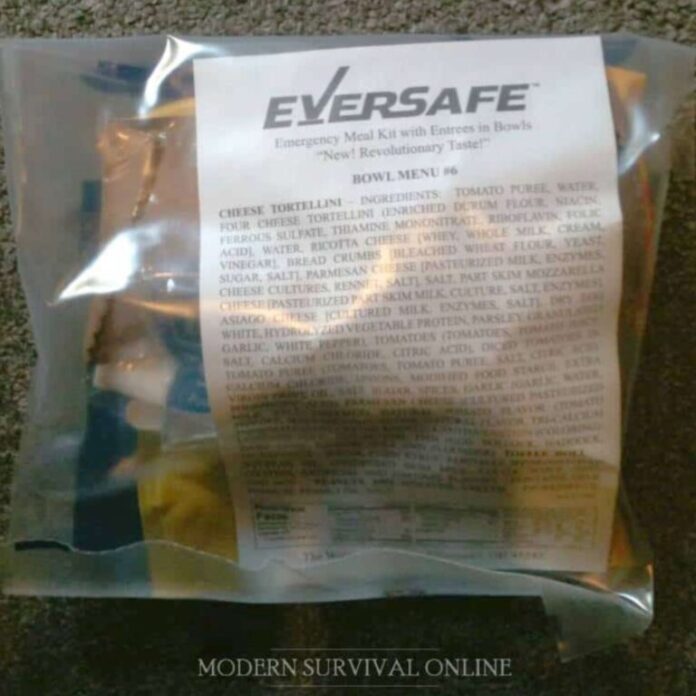MREs have evolved past the point of just feeding the military while they are out in the field. Each country has its version of these easy-to-prepare meals, with the Canadian IMP (Individual Meal Pack) as a good comparison.

MREs have become famous among civilians who enjoy the many components found within.
Meals Ready to Eat (MREs) are self-contained, ready-to-eat meals that are shelf stable, typically used when regular food isn’t available such as during military operations, or during disasters.
MREs were developed in the United States for use by the military in the field, and each package has a diverse menu inside that can be eaten hot or cold.
Preppers, survivalists, and even campers have been using these meals for years as easy-to-store food options.
If you’re new to the world of MREs, this guide will show you the history of these shelf-stable items as well as why you should have some in your food stash for emergencies.
What Are MRE Meals?
Contained inside the package of an MRE are a lot of different things, ranging from light snacks to full entrees.
The idea behind them is that they’re complete meals with enough calories and nutrition to get you through the day.
While they might not be the healthiest choice of food, they can work in a pinch during a survival situation.
The Common Uses of an MRE
Historically, MREs were used by the military to feed the troops high-quality meals while they were deployed.
This has since spilled over into the general population, and many preppers will keep a stock on hand in case of an emergency.
They are the perfect addition to anyone’s kit, whether you’re camping, prepping, or just need a portable meal when there isn’t a reliable food source nearby. Other industries that use MREs include:
- Law enforcement
- Fire departments
- Hospitals
- Red Cross
- Other private entities
The durability and long shelf life are starting to attract others as well. Hikers and outdoor sports enthusiasts are more often seen carrying them inside their packs.
This makes sense as everything is lightweight and self-contained, perfect for the ounce-cautious backpacker.
Pros and Cons of MREs
You can probably start to understand some of the advantages and disadvantages of eating MREs.
In this case, the pros may outweigh the cons in many scenarios where food sources are scarce.
| Pros | Cons |
|---|---|
| + All-in-one meal solution that’s portable | – Shelf life of 3-5 years does not make it a good solution for long-term food |
| + Provides enough nutrition to keep you going | – The chemicals and preservatives used are not healthy |
| + Can be eaten hot or cold | – Can be quite expensive to purchase |
| + Longer shelf life than other products |
A Brief History of MREs
Back in the early 1900s, rations were used instead of the MRE and often only included meat and bread.
This was too basic of a nutrition regimen and thus, various soldiers started to show signs of nutritional deficiencies.
Canned rations emerged to save the day and contained ready-to-eat entrees that didn’t need to be heated. This allowed for a wider variety of food that could meet the nutritional needs of the soldiers.
The Department of Defense (DoD) in the United States first adopted the MRE concept in 1975. The first MRE was manufactured that same year, with large-scale production starting in 1978.
Operation Desert Storm helped push MRE development forward as they ate these meals for more than 60 days. This prompted the addition of bread, chocolate that didn’t melt, and the popular flameless ration heater (FRH).
By 1998 there were 24 different menus, and in 1999, the civilian MRE made it to the market.
There were MREs for civilians before this, but they were bland and mundane, unlike the military versions.
Manufacturers weren’t allowed to sell MREs to civilians before this time but, thanks to a rise of natural disasters they were desperately needed.
The MRE has since undergone countless transformations, including additions and tweaks to existing components.
It continues to this day and among some communities have become something of a collector’s item.

What Are MREs Actually Made Of?
MREs come in kits, typically in a trilaminate retort pouch that is made of thick aluminum foil and durable plastic.
The contents will vary, depending on the menu selection, and what additions they include. At the very least you can expect the following in your MRE:
- A main course
- 1-2 side dishes
- Bread
- Peanut butter or jelly
- Dessert (cookies, bars, chocolate)
- Coffee or tea
- Cold drink mixes
- Hot chocolate
- Cream and sugar
- Salt, Pepper
- Utensils
- Napkin or wet napkin
- Gum
Many will consider that just the typical configuration. Some come with unique items such as specialty chocolate or different flavored jams.
MREs come packed in cases of 6 and 12, you can also find individual ones for sale online.
How Are Meals Ready To Eat Prepared?
MREs have been eaten cold for decades and unfortunately, that’s the way the dice fall in some situations.
The manufacturers had intended on them being heated up so if you’re able to, it’s highly recommended.
A Flameless Ration Heater (FRH) is usually included in every MRE, and is the easiest way to reheat the entrees and any side dishes.
The heater will come as a bag and inside is a chemical packet that is highly reactive to water.
Using an FRH is simple: add water to the bag, place your items inside, and seal (leave a small air hole for steam to escape).
You’ll notice quickly if the heater is working when you hear the sizzle of water, and the bag starts to expand as it heats up. Leave your food packets inside for several minutes or until piping hot.
Sometimes the FRH is a dud, and won’t start. In this case, there are several other methods in which you can heat your MRE with ease.
- Leave near a warm heat source such as a radiator or fire
- Sit in boiling water for up to 5 minutes
- Remove the contents from the pouch and microwave for 4 minutes
As a note of caution, you should never apply a direct flame to an MRE pouch since the metal interior could get damaged or leach into the food contents.

Are MREs Healthy For You?
If you’re considering using MREs for an emergency, or extended camping trips it’s wise to know what you’re actually eating to see if it’s sustainable for long-term consumption.
There’s quite a bit of nutrition packed into an MRE, but with that comes some risks if you consume too much.
Nutrition Content
MREs have enough calories to keep you going. They can range anywhere from 500 to 2500+ calories per package with the average being about 1250 calories.
They are put together to provide the maximum amount of nutrients and calories for the short term.
This means that if a soldier eats three MREs a day, then they are getting the maximum daily allowance of vitamins and energy.
Each menu has a different nutritional breakdown to show you what each component is giving you.
The health problems can be from what gives them a long shelf life. Most shelf-stable foods come laden with preservatives, MSG, seed oils, and other artificial chemicals.
Eating them in the long term can cause health problems as a lot of the ingredients are not good for our bodies.
However, the meals are designed to get you through a mission or a camping trip, not to be your primary food source.
How Many Should You Eat in a Day?
A single MRE is designed to feed one person for one meal of the day. It’s recommended that you don’t eat more than three of these per day.
This provides the recommended amount of nutrition and calories required by the U.S. Military.
How Long Can You Eat MREs For?
It is recommended that you only eat MREs for a maximum of 21 days. Any more and you risk upsetting the microbiome in your stomach, leading to problems within the body.
It can also lead to a nutritional imbalance within the soldier, affecting cognitive and motor skills.
Are There Any Side Effects From Eating MREs?
Consistently eating MREs can lead to some internal issues, the primary symptoms being constipation and sometimes severe diarrhea.
This is mainly caused by the large amount of sugar, protein, and fat inside the MRE.
They are supposed to be eaten and then used as energy immediately and any other use can jam up the system, so to speak.
How To Store MREs Properly
Storing MREs is pretty much the same as any other dehydrated or freeze-dried foods.
Heat, moisture, light, and oxygen can cause an MRE to spoil, so it’s best to plan around that. If you purchase a case of them make sure to keep it off the ground and in a cool dark place.
In the field keep your MRE safe from anything that could puncture or cut the retort pouch. This means packing it away from knives, axes, and saws.
Unless you’re heating them, try to keep them out of direct sunlight or near a fire.
How Long Do MREs Last?
MREs are designed to be shelf stable for 3-5 years at a consistent temperature of 80 °F / 26 °C or for up to nine months at 100 °F / 37 °C.
The contents will more than likely still be edible after that time but the nutritional content might have degraded. You might also notice a decline in the quality as the preservatives start to go rancid.
Frequently Asked Questions
Many people will still have a lot of questions about MREs so here’s a list of the most common questions we see about these portable meals.
What does MRE stand for?
MRE stands for Meals Ready-to-Eat, which aptly describes the contents.
What does the average MRE weigh?
Each MRE weighs approximately 18-26 ounces and each case is about 21 pounds.
What does an MRE taste like?
While the flavor will differ depending on the menu choice, MREs have been described as a generic “food out of a can” taste.
How long do MREs last frozen?
Expect a shelf life of over 10 years if you freeze your MRE. The packaging protects the contents from freezer burn.
How many rations are in a pack?
MREs generally come in cases of 6 or 12 individual meals.


